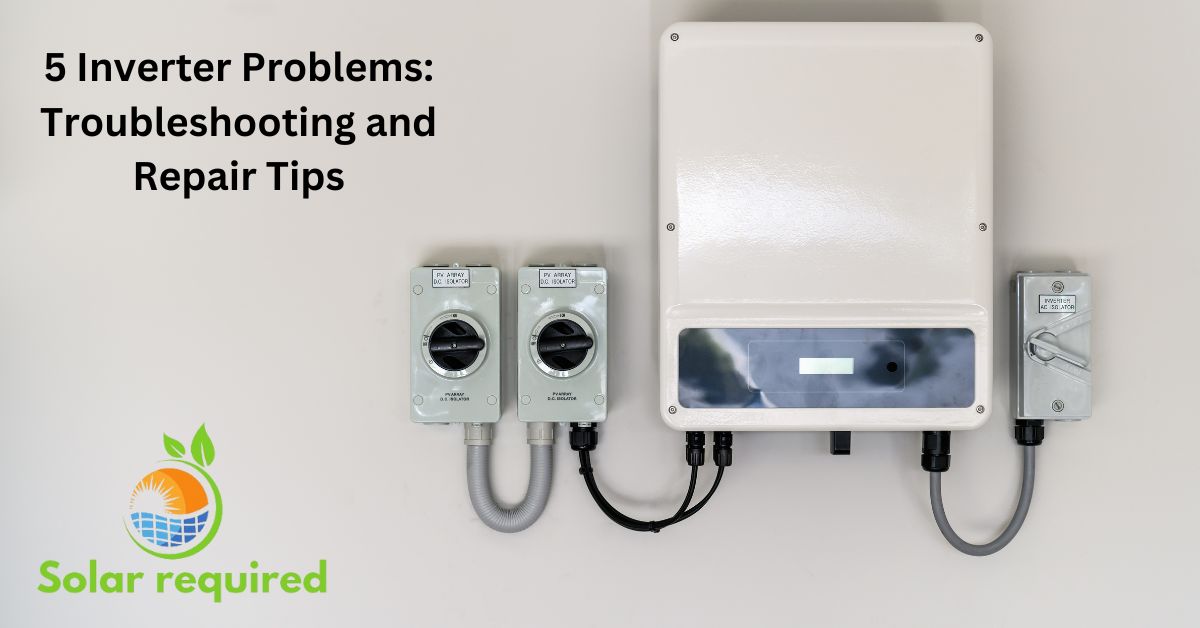Inverter Failures
Inverters are crucial to Solar Panels and modern life. They convert DC electricity to AC power. The inverter and the entire solar panel system can have problems. You can use them to power your house or workplace. You can also use them in portable inverters while traveling.
On the other hand, inverters can malfunction just like any other electrical gear. Inverter failures can be annoying and inconvenient. But you can quickly fix your inverter with the right diagnostic and repair methods.
Common Signs of Inverter Failures
Understanding the typical symptoms of inverter failures is critical before beginning troubleshooting. The most obvious is a total loss of power production. If your inverter isn’t producing AC power when you switch it on, a problem might have to be fixed. Variations in power production are another typical indicator.
Your inverter may be failing. You can tell because your lights flicker or your appliances act strangely. Unusual sounds, such as buzzing or humming, might also be signs of impending collapse. Knowing these signs can help you spot problems early. Then, you can take the right action.

5 Common Inverter Problems
1. Inverter overheating:
Inverters for solar panels can overheat, especially in areas with high temperatures and little airflow. They may not function as well or may even shut down if they overheat. It’s crucial to position the inverter where air can circulate around it. This prevents this.
Solution:
Keep the inverter in a cool place with good airflow. Make sure it’s not in direct sunlight or blocked by anything. Regularly clean any dirt or dust that might block the vents.
2. DC Arc Faults:
Sparks may occasionally occur from electricity jumping between the solar panels’ wires. This is risky and may harm the inverter. Usually, animal tampering with the panels, broken wiring, or loose connections are the causes. You can avoid this by routinely inspecting the cables and addressing any issues.
Solution:
Check the wires and connections in the solar panels often to make sure they’re tight. If you see any damaged wires, replace them right away. You can also use special devices that detect and stop arcs.
3. Ground Faults:
A ground fault occurs when the cables in the solar panels unintentionally come into contact with the earth. This may happen if the wires sustain damage. Or if the insulation around them breaks. Accidents and damage to the inverter might result from ground faults. This can be avoided by making sure the wires are adequately insulated and by regularly inspecting them.
Solution:
Make sure the wires are properly connected to the ground. Check them regularly for any damage. You can also use devices that detect if the wires are touching the ground when they shouldn’t be.
4. Isolation Faults:
When the inverter’s insulation fails, it causes isolation issues. This may result in dangerous electrical leaks where they shouldn’t. Damage to the inverter or general wear and tear can result in isolation issues. Frequent maintenance can help find and fix these issues. It does so before they become more serious.
Solution:
Check the inverter regularly to make sure everything is working properly. If you see any signs of damage or wear, fix them right away. You can also test the insulation to make sure it’s doing its job.
5. Fan noise in the inverter
The fan noise in the inverter can be a problem if the inverter’s circuit is damaged. The heat will reduce the inverter’s current or even cause it to fail.
Troubleshooting Inverter Failures
Troubleshooting is the first thing to do when an inverter fails. Please make sure the power source is connected and start inspecting it. An imperfect or loose connection might occasionally lead to an inverter malfunction. Examine the inverter’s interior parts after ensuring the power supply is functioning properly.
Check for any burned-out capacitors, blown fuses, or loose wires. These often cause inverter malfunctions. Changing the bad parts usually fixes them. If the problem continues, you might need to check the inverter’s user manual. Or, you can contact the manufacturer for more troubleshooting help.
Inverter Error Codes problem
A useful tool for determining the root cause of the failure is an inverter’s error code. An error code is frequently displayed on an inverter’s control panel or LCD screen when an issue arises. The codes make troubleshooting and repair easier. They give key information about the nature of the issue. It’s vital to check the inverter’s handbook or the manufacturer’s website. They have a full list of error codes and their explanations. Each maker may have its own set of codes. Knowing these codes can help you identify the issue and take the necessary action fast.
Repairing Minor Inverter Issues
Not every inverter malfunction calls for specialized assistance or involved repairs. There are a few small problems that you can resolve on your own. For instance, dust or debris can block the cooling fan of your inverter. This blockage can make it overheat and fail. This can be fixed by cleaning the fan and making sure there is enough airflow.
Loose connections are yet another frequent issue. Wires may become loose due to the oscillations produced by the inverter’s functioning over time. Usually, the issue can be resolved by only tightening the connections. Keep in mind: always cut the power and take safety steps.
Replacing faulty components
In certain instances, an inverter component gone bad could be the cause of the failure. Over time, parts like transformers, diodes, and capacitors may deteriorate and fail. You can try to change these parts on your own if you feel comfortable doing so and you have prior knowledge of electronics. But it’s important to have the right parts.
And to use the right soldering methods. It’s better to get expert help if you are unsure about this repair. Or, if you are uncomfortable doing it yourself. An experienced technician will have the know-how and resources. Finding and replacing broken parts requires their assistance.

When to Seek Professional Help for Inverter Repair
Some small problems can be fixed by yourself. But, other times you need professional help. It’s time to get professional help if you can’t figure out what caused the failure or if troubleshooting doesn’t resolve the issue. Also, DIY repairs could void the guarantee if the inverter is still covered. Experts have the expertise to find complex issues.
They can find real replacement parts and ensure a full fix. They may also offer helpful guidance on maintenance. It will prevent problems and make your inverter last longer.
Preventive Maintenance for Avoiding Inverter Failures
To reduce the chance of inverter failure, you must perform preventive maintenance regularly. First, arrange for regular inspections to find any possible problems before they become more serious. Examine the inverter for any visible damage, loose connections, or corrosion. You can avoid overheating by cleaning the fan and vents on the inverter.
Do this routinely. Also, place the inverter away from intense heat or the sun. Put it in a well-ventilated spot. Testing the inverter’s performance regularly is also crucial. Early detection of any deviations or irregularities can be done by measuring the voltage. You can achieve this by monitoring it.
Importance of Regular Inspections
Your inverter’s longevity and dependability depend on routine testing and inspections. You can see signs of wear, loose connections, or damage. You can see them by inspecting the area. Taking quick action can avoid many problems.
They can become serious and need costly repairs. You can watch the inverter for efficiency. By testing it often, you can find any issues. Additionally, it offers a chance to recalibrate the inverter if required. Never forget: preventive maintenance saves money. It also causes less disruption than waiting for a problem.
When investing in solar energy, most people focus on solar panels. However, the solar panel frame is just as important. A high-quality solar panel frame provides durability, efficiency, and cost savings
Conclusion and Final Thoughts
Inverter failures might be annoying. But you can fix them and get your inverter working again. Just use the right troubleshooting methods and repair advice. You can keep your inverter running smoothly for many years. To do this, be aware of the common signs of failure, how to fix problems, and the importance of regular maintenance. When working on your inverter, always put safety first and get expert help when necessary. You may have peace of mind and an uninterrupted power supply by taking good care of your inverter and fixing any problems as soon as they arise.


